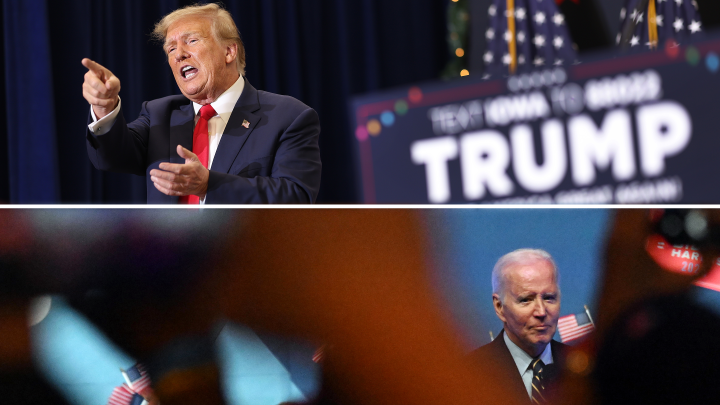
The 2024 election cycle is going to be very, very expensive
The 2024 election cycle is going to be very, very expensive

Elections are expensive, and the 2024 presidential election is no exception.
A new report from AdImpact predicts that the 2023-24 election cycle will be the costliest of all time, with candidates expected to spend cumulatively more than $10 billion in political pitches across various platforms. For major candidates, fundraising hasn’t been an issue. The campaigns of Joe Biden and Donald Trump raised more than $24 million each during the third quarter.
Sheila Krumholz, executive director of political money tracker OpenSecrets, spoke with “Marketplace” host Kimberly Adams about election spending so far and how it’s likely to unfold in 2024. The following is an edited transcript of their conversation.
Kimberly Adams: We are firmly in election season now, so what are some of the spending trends that you’ve been noticing so far?
Sheila Krumholz: Well, it’s interesting. Total outside spending is surprisingly high for this point in the cycle — we’re already at nearly $230 million. That’s more than twice the previous record through this point in the cycle, which was back in 2016. But it’s more than five times as much as was spent by this point in the last presidential cycle in 2020. Of course, the usual inflation caveats apply.
Adams: So when you say “outside spending,” what are you talking about?
Krumholz: Super [political action committees] in particular, but it can also be politically active nonprofits. It can be shell corporations spending independently. So this is money not spent by the candidates or by political committees that report to the [Federal Election Commission] other than super PACs. These independent expenditure-only committees, they are supposed to be independent. This is not necessarily the case, but that is the law.
Adams: Nooooo … you mean that there’s coordination possibly?
Krumholz: You know, I think if there is coordination, they’re just being sloppy because it’s so easy for a candidate to telegraph their intent and have outside groups not break the law, not do anything illegal, but kind of pick up the baton. These outside groups really, especially super PACs that are single candidates, super PACs really are just an extension of the campaigns at this point.
Adams: We saw progressive candidates shift to sort of emphasizing smaller donations, almost as far back as 2016, and conservative candidates have been doing the same in more recent cycles. What’s the balance between small- and large-dollar donors nowadays?
Krumholz: Small-dollar donors are making up a huge portion of the donations and a growing portion with each election cycle. Unfortunately, a lot of the money’s going through these joint fundraising committees that are raising money for the candidates but also for the parties and other committees, including national and state-level party committees. But we know based on each past election cycle that the percentage coming from small donors is growing with each passing cycle.
Adams: A report from AdImpact predicted that the 2024 cycle will be the most expensive campaign ever, and I wonder how that lines up with what you’re seeing so far.
Krumholz: It’s still very early. At this point, we won’t get the year-end filings until Jan. 31 of next year. But if trends hold with what we’re seeing in outside spending, we’re easily on record-setting outside spending pace — in which case, those predictions of record-breaking political ad spending seem totally reasonable to me.
Adams: Where are these campaigns and PACs and super PACs and these outside groups — where are they spending their money, and how are they spending it?
Krumholz: Well, typically at this point in the cycle, the outside groups are running advertising to present the candidates, the presidential candidates in particular in this case, to the American public, to in many cases introduce them. And, of course, we don’t really know where a lot of the money is coming from because of course, they don’t want to expose where the money is coming from. It might conflict with the campaign’s messaging.
Adams: So, overall, how do you expect the money side of this election cycle to look different from campaigns of the past?
Krumholz: In campaign finance and in regulation of campaign finance, it’s always been kind of a cat-and-mouse game: two steps forward, one step back. So as technology offers new options for campaigns to get around some of the limitations of our campaign finance regulations, I’m sure that we’ll continue to see creative developments and innovations in campaigning and electioneering. And, you know, it’ll be up to the press, the public and policymakers to figure out where to draw the line and to stay on top of those trends.
There’s a lot happening in the world. Through it all, Marketplace is here for you.
You rely on Marketplace to break down the world’s events and tell you how it affects you in a fact-based, approachable way. We rely on your financial support to keep making that possible.
Your donation today powers the independent journalism that you rely on. For just $5/month, you can help sustain Marketplace so we can keep reporting on the things that matter to you.

















